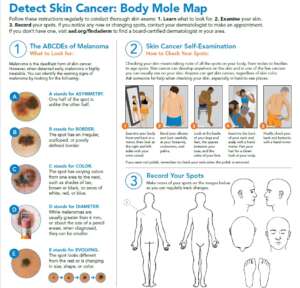By getting into the habit of checking your skin, you can learn what your moles look like. Once you know what your moles look like, you’ll be able to spot changes. In adults, a change to a mole or the sudden appearance of a new mole can be a sign of melanoma. Melanoma is a type of skin cancer that can be deadly if not caught early and treated.
Finding melanoma early is essential. Melanoma has a cure rate of nearly 100% when found early and properly treated.
The best way to check your skin is to perform a skin self-exam. You can perform this exam at home. You will need a room where you can undress and have access to a full length mirror and a handheld mirror. It also is helpful to use a body mole map to track changes on your skin.
A skin self-exam means you’ll need to look at all of your skin. Moles can appear anywhere on your skin – the scalp, between fingers, on a toe or the sole of the foot. You can even get a mole under your nail.
As you examine your skin, you will look at each individual mole.

